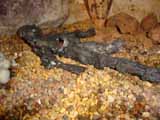|
|
TODAY.AZ / World news
First Turkish researcher enters Chinese pyramids
07 April 2010 [11:06] - TODAY.AZ
 Oktan Keleş, a Turkish researcher who has been studying the legendary ‘Chinese Pyramids’ of Xi’an for many years, recently entered the structures for the first time. Although others have visited in the past, only his team was permitted to take photographs of the interior. He says revelations from the pyramids could change the way history is written.
Oktan Keleş, a Turkish researcher who has been studying the legendary ‘Chinese Pyramids’ of Xi’an for many years, recently entered the structures for the first time. Although others have visited in the past, only his team was permitted to take photographs of the interior. He says revelations from the pyramids could change the way history is written.In a visit that could change the writing of Turkish and Chinese history, a Turkish researcher has entered the legendary “Chinese Pyramids,” located roughly 100 kilometers from Xi’an, for the first time.
Speaking to Anatolia news agency last week, Oktan Keleş, a Turkish researcher who has been researching the pyramids for many years, said the ancient mausoleums were of great importance for Turkish history and could change established approaches to history.
“Once the material inside the pyramids is examined by experts, history could be re-written,” Keleş said.
The scattered pyramids have also been termed the “Turkish Pyramids” or “The Great White Pyramid.”
Other researchers have gone to the region in the past but were not given permission to take photos, Keleş said, adding that research conducted by German scientists had been instrumental in furthering knowledge of the area, but could not be proven given a lack of photographs.
Despite previous prohibitions against taking photographs inside the pyramids, Keleş was able to photograph some of the interior of the structure. “As far as we know, our shots are the most comprehensive ones.”
Several symbols, statues and tablets inside the pyramids might belong to ancient Turks, he said, adding that Chinese officials told him the symbols and signs were from Uyghurs, who served as hired soldiers instead of the Chinese in early periods.
“This, however, is the [Chinese] claim,” Keleş said.
Relating his first tour of the pyramid, Keleş said he and some others, along with a local Chinese guide, walked 40 to 50 meters in the dark in a natural cave. “We reached a three-channeled entrance in that cave. Later we came to a large area and the Chinese guide told us that we were inside the pyramid.”
Noting that the pyramid was established on a natural formation, Keleş said they entered a crypt and saw “wolf head” figures on a rock, as well as a three-meter statue made of granite which had “crescent and star” carvings.
“The Chinese guide told me that the statue represented ancient Turkish leader Oğuz Kağan,” Keleş said.
Later, the researcher said the guide pointed out a mummy belonging to a man. “His face was clearer 30 years ago. We stayed there for about seven-eight minutes but then the guide told us to leave immediately. We wanted to examine the area a bit more but he refused. We saw stairs going down and wanted to go there but he said that it would be very difficult to go down and repeated that we had to leave there. We could not go down but we saw that there were written tablets on the walls.”
According to information provided by the guide, Keleş said, there was another mummy in the bottom section of the pyramid that had not been distorted.
The “Chinese Pyramids,” located to the northwest of Xi'an on the Qin Chuan Plains in Shaanxi Province, are ancient mausoleums and burial mounds.
Believed to be the burial places of various emperors and generals, the pyramids range in size from relatively small to others that rival the Great pyramid of Giza, sources say.
Interest in Chinese pyramids was greatly increased by the 1994 publication of German author Hartwig Hausdorf's book “Die Weisse Pyramide,” later translated into English under the revised title “The Chinese Roswell,” in which he describes his travels through China in search of the legendary great white pyramid of China.
/Hurriyet Daily News/
URL: http://www.today.az/news/regions/65587.html
 Print version
Print version
Views: 3387
Connect with us. Get latest news and updates.
See Also
- 27 December 2025 [23:33]
Thailand–Cambodia temporary ceasefire enters into force - 27 December 2025 [21:23]
Syria to lunch new banknotes, begin currency replacement on January 1 - 27 December 2025 [10:00]
Road freight transportation from Georgia to Armenia and Turkiye partially suspended - 27 December 2025 [09:00]
Top 10 most affordable sports cars - 27 December 2025 [08:00]
Kuwait ban energy drink sales to minors - 26 December 2025 [22:25]
Korean tech firms reveal AI robots at CES 2026 - 26 December 2025 [21:23]
Türkiye launches national disaster program for kids - 26 December 2025 [20:19]
UK living standards expected to decline - 26 December 2025 [18:00]
Georgia requires health insurance for all foreign visitors from next year - 26 December 2025 [09:00]
China accelerates maglev flatcar to 700 km/h
Most Popular
 Pakistan’s expanding defence partnerships put Azerbaijan in strategic spotlight
Pakistan’s expanding defence partnerships put Azerbaijan in strategic spotlight
 US Embassy commemorates anniversary of Azal plane crash
US Embassy commemorates anniversary of Azal plane crash
 Baku ask world uncomfortable questions. We are waiting for response
Baku ask world uncomfortable questions. We are waiting for response
 President Ilham Aliyev makes post on anniversary of AZAL plane crash
President Ilham Aliyev makes post on anniversary of AZAL plane crash
 Xiaomi introduces the 17 Ultra smartphone
Xiaomi introduces the 17 Ultra smartphone
 Student Loan Fund announces partial forgiveness for 2,360 graduates
Student Loan Fund announces partial forgiveness for 2,360 graduates
 VP Y?lmaz highlights economic, security, climate agenda amid regional cooperation move
VP Y?lmaz highlights economic, security, climate agenda amid regional cooperation move
